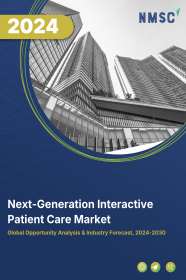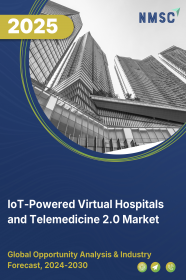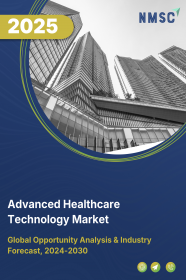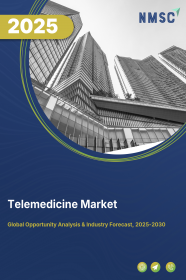
Next-Generation Interactive Patient Care Market by Product Type (Hardware and Software), by Type (inpatient and Outpatient), by Application (Telehealth, Remote Patient Monitoring, and Others), and by End-User (Hospitals, Clinics, Home Care, and Ambulatory Care Center)- Global Opportunity Analysis and Industry Forecast 2024-2030
US Tariff Impact on Next-Generation Interactive Patient Care Market
Trump Tariffs Are Reshaping Global Business
Market Definition
The Next-Generation Interactive Patient Care Market size was valued at USD 205.6 million in 2023 and is predicted to reach USD 557.6 million by 2030 with a CAGR of 15.3% from 2024-2030. Next-generation interactive patient care refers to the use of advanced technology to provide healthcare services remotely and digitally to patients. It includes the use of telehealth, remote patient monitoring, and other digital tools to improve communication & collaboration between healthcare providers and patients to enable patients to take a more active role in their own care. Telehealth allows patients to access medical advice and treatment remotely through video conferencing, phone calls, or messaging. Remote patient monitoring (RPM) enables healthcare providers to monitor patients' vital signs and other health data remotely, using wearable devices or other digital tools for early detection and treatment of diseases. It also includes the use of various digital tools such as electronic health records (EHRs), personal health records (PHRs), and mobile health (mHealth) apps that allow patients to access their health information, communicate with healthcare providers, and manage their own care.
Market Dynamics and Trends
The next-generation interactive patient care market is significantly boosted due to the growing prevalence of chronic diseases such as arthritis, cardiovascular disorders, kidney diseases, and respiratory disease across the globe. According to the recent report published by the World Health Organization (WHO), 41 million people across the globe die every year due to chronic disease, equivalent to 74% of all deaths. With such a high burden of chronic illnesses, there is a growing need for advanced patient care solutions to manage and treat these conditions effectively.
Moreover, the increasing adoption of advanced technology such as the use of telemedicine for remote patient monitoring and virtual consultations is further driving the growth of the market. As per the latest report published by the American Medical Association, telemedicine adoption is growing at a significant rate across the globe, with adoption rate growing at 20%-25% in 2024. The adoption is driven by the growing demand for remote patient monitoring, allowing patients to track their health and manage their conditions.
Furthermore, the rising geriatric population across the globe, who are prone to numerous chronic diseases, is further driving the growth of the market. According to the latest report published by the World Health Organization, 1.4 billion people are estimated to be above the age of 60 by 2030, and it is anticipated to reach 2.1 billion by 2050.
However, the high cost of next-generation interactive patient care systems is the major factor restraining the growth of the market. On the contrary, the introduction of artificial intelligence along with virtual reality (VR) and augmented reality (AR) technologies in the healthcare industry to provide immersive therapy, rehabilitation, simulations for surgical training, and create virtual environments for physical therapy are expected to create ample opportunities in the coming years.
Market Segmentations and Scope of the Study
The next-generation interactive patient care market share is segmented on the basis of product type, type, application, and end user. On the basis of product type, the market is divided into hardware and software. Hardware is further divided into television, IBT/ assisted devices, and tablets. On the basis of type, the market is classified into inpatient and outpatient. On the basis of application, the market is segmented into telehealth, remote patient monitoring, and others. On the basis of end user, the market is divided into hospitals, clinics, home care, and ambulatory care center. Geographic breakdown and analysis of each of the aforesaid segments include regions comprising of North America, Europe, Asia-Pacific, and RoW.
Geographical Analysis
North America holds the lion share of the next-generation interactive patient care market and is expected to continue its dominance during the forecast period. This is attributed to factors such as the growing prevalence of chronic disease due to unhealthy lifestyles in countries such as the U.S. and Canada. According to the Center for Disease Control and Prevention and National Center for Chronic Disease Prevention and Health Promotion (NCCDPHP), 6 out of 10 adults in the United States have a chronic disease such as heart disease, cancer, or diabetes.
Moreover, the presence of key players such as Epic Systems Corporation and GetWellNetwork Inc plays an important role in the growth of the next-generation interactive patient care market in this region. These companies contribute significantly to the development and adoption of innovative patient care solutions, leveraging advanced technologies to improve healthcare delivery and patient outcomes. For instance, in September 2022, Epic Systems Corporation launched its life-science program to help providers, pharmaceutical companies, and medical device manufacturers to expand clinical trial and speed up the development of new therapies for interactive patient care.
On the other hand, Asia Pacific is expected to show a steady rise in the growth of the next-generation interactive patient care market due to the rapidly growing healthcare industry along with the improving healthcare infrastructure in major economies such as China, Singapore, and Japan. According to the International Trade Administration, the healthcare sector in Singapore is expected to reach USD 49.4 billion by 2029, driven by the growing adoption of advance healthcare facilities including interactive patient care services in this region.
Moreover, the increasing investment by the governments to provide high-quality healthcare facilities in emerging economies such as China, India, and South Korea is further driving the growth of thew market in this region. For instance, in July 2022, the World Bank approved USD 1 billion fund for India's Pradhan Mantri-Ayushman Bharat Health Infrastructure Mission. Through this, the government aims to invest in universal access to equitable, affordable, and quality healthcare facilities to the public.
Competitive Landscape
Various market players operating in the next-generation interactive patient care market include GetWellNetwork Inc, Epic Systems Corporation, SONIFI Health, Barco NV, Koninklijke Philips N.V., Advantech Co. Ltd.,, Aceso, HealthHub Patient Engagement Solutions, Lincor Inc, Remedi Technology and others. These market players are adopting various strategies such as product launches to remain dominant thein the next-generation interactive patient care market.
For instance, in November 2022, Koninklijke Philips N.V. launched an AI-enhanced solution to increase diagnostic for medical imaging to diagnose diseases and guide their treatment. Through this, the company aimed to help speed up imaging, enabling the interpretation of massive datasets in seconds to drive diagnostic and operational efficiency.
Moreover, in November 2022, Salesforce Inc launched Patient 360 for Health that provides real-time patient data for healthcare and life sciences organizations. Through this, the company aimed to deliver comprehensive patient care with greater efficiency. Furthermore, in February 2022, IRRAS AB launched the next generation of the IRRAflow System in the U.S. Through this launch, the company aimed to treat critically ill patients with intracranial bleeding to remove and prevent solid particles from blocking drainage holes.
KEY BENEFITS
-
The report provides quantitative analysis and estimations of the next-generation interactive patient care market from 2024 to 2030, which assists in identifying the prevailing market opportunities.
-
The study comprises a deep-dive analysis of the next-generation interactive patient care market including the current and future trends to depict prevalent investment pockets in the market.
-
Information related to key drivers, restraints, and opportunities and their impact on the next-generation interactive patient care market is provided in the report.
-
Competitive analysis of the players, along with their market share is provided in the report.
-
SWOT analysis and Porters Five Forces model is elaborated in the study.
-
Value chain analysis in the market study provides a clear picture of roles of stakeholders.
KEY MARKET SEGMENTS
By Product Type
-
Hardware
-
Television
-
IBT/ Assisted Devices
-
Tablets
-
-
Software
By Type
-
Inpatient
-
Outpatient
By Application
-
Telehealth
-
Remote Patient Monitoring
-
Others
By End-User
-
Hospitals
-
Clinics
-
Home Care
-
Ambulatory Care Center
By Region
-
North America
-
The U.S.
-
Canada
-
Mexico
-
-
Europe
-
The UK
-
Germany
-
France
-
Italy
-
Spain
-
Denmark
-
Netherlands
-
Finland
-
Sweden
-
Norway
-
Russia
-
Rest of Europe
-
-
Asia Pacific
-
China
-
Japan
-
India
-
South Korea
-
Australia
-
Indonesia
-
Singapore
-
Taiwan
-
Thailand
-
Rest of Asia Pacific
-
-
RoW
-
Latin America
-
Middle East
-
Africa
-
REPORT SCOPE AND SEGMENTATION:
|
Parameters |
Details |
|
Market Size in 2023 |
USD 205.6 Million |
|
Revenue Forecast in 2030 |
USD 557.6 Million |
|
Growth Rate |
CAGR of 15.3% from 2024 to 2030 |
|
Analysis Period |
2023–2030 |
|
Base Year Considered |
2023 |
|
Forecast Period |
2024–2030 |
|
Market Size Estimation |
Million (USD) |
|
Growth Factors |
|
|
Countries Covered |
28 |
|
Companies Profiled |
20 |
|
Market Share |
Available for 10 companies |
|
Customization Scope |
Free customization (equivalent up to 80 working hours of analysts) after purchase. Addition or alteration to country, regional, and segment scope. |
|
Pricing and Purchase Options |
Avail customized purchase options to meet your exact research needs. |
KEY PLAYERS
-
GetWellNetwork Inc
-
Epic Systems Corporation
-
SONIFI Health
-
Barco NV
-
Koninklijke Philips N.V.
-
Advantech Co. Ltd.
-
Aceso
-
HealthHub Patient Engagement Solutions
-
Lincor Inc
-
Remedi Technology

















 Speak to Our Analyst
Speak to Our Analyst





















